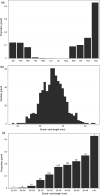Demographics, reproduction, growth, and abundance of Jollyville Plateau salamanders (Eurycea tonkawae)
- PMID: 28690826
- PMCID: PMC5496537
- DOI: 10.1002/ece3.3056
Demographics, reproduction, growth, and abundance of Jollyville Plateau salamanders (Eurycea tonkawae)
Abstract
Insights into the ecology and natural history of the neotenic salamander, Eurycea tonkawae, are provided from eight years of capture-recapture data from 10,041 captures of 7,315 individuals at 16 sites. Eurycea tonkawae exhibits seasonal reproduction, with peak gravidity occurring in the fall and winter. Size frequency data indicated recruitment occurred in the spring and summer. Open-population capture-recapture models revealed a similar seasonal pattern at two of three sites, while recruitment was dependent on flow at the third site. Females can reach sexual maturity within one year, and oviposition likely takes place below ground. The asymptotic body length of 1,290 individuals was estimated as 31.73 mm (at ca. two years of age), although there was substantial heterogeneity among growth trajectories. Longevity was approximately eight years, and the median age for a recaptured adult was 2.3 years. Abundance estimated from closed-population and robust-design capture-recapture models varied widely within and among sites (range 41-834), although, surprisingly, dramatic changes in abundance were not observed following prolonged dry periods. Seasonal migration patterns of second-year and older adults may help explain lower ratios of large individuals and higher temporary emigration during the latter half of the year, but further study is required. Low numbers of captures and recaptures precluded the use of open-population models to estimate demographic parameters at several sites; therefore, closed-population (or robust-design) methods are generally recommended. Based on observations of their life history and population demographics, E. tonkawae seems well adapted to conditions where spring flow is variable and surface habitat periodically goes dry.
Keywords: Plethodontidae; natural history; reproductive phenology; von Bertalanffy.
Figures







References
-
- Bendik, N. F. , & Gluesenkamp, A. G. (2013). Body length shrinkage in an endangered amphibian is associated with drought. Journal of Zoology, 290, 35–41.
-
- Bendik, N. F. , Sissel, B. N. , Fields, J. R. , O'Donnell, L. J. , & Sanders, M. S. (2014). Effect of urbanization on abundance of Jollyville Plateau salamanders (Eurycea tonkawae). Herpetological Conservation and Biology, 9, 206–222.
-
- Bogart, J. P. (1967). Life history and chromosomes of some of the neotenic salamanders or the Edward's [sic] Plateau. Unpublished Master's thesis. The University of Texas at Austin, Austin, Texas. 80 pp.
LinkOut - more resources
Full Text Sources
Other Literature Sources

